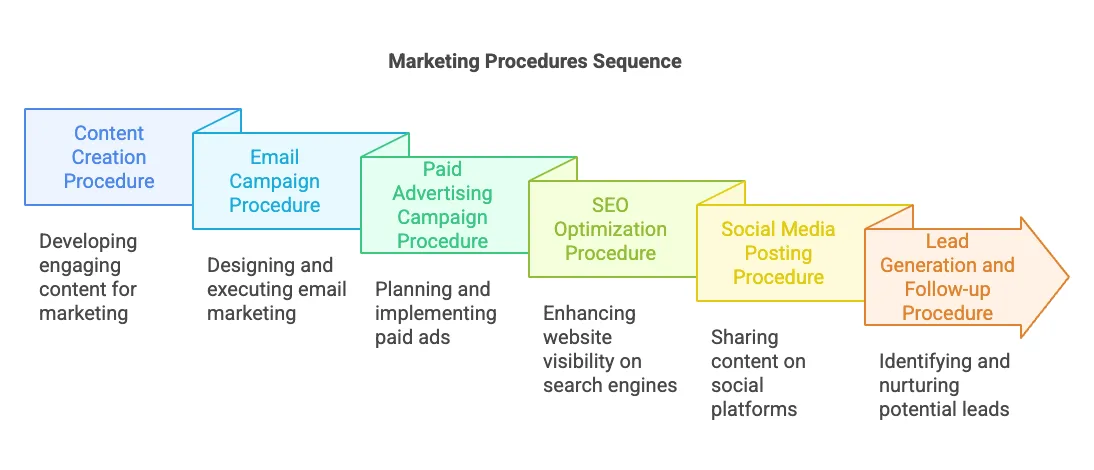Marketing Procedures
Marketing Procedures are the specific, step-by-step actions or instructions that a marketing team follows to carry out various marketing activities. These procedures ensure consistency, efficiency, and quality in executing marketing tasks, campaigns, and operations. Marketing procedures are often formalized as part of Standard Operating Procedures (SOPs) to guide team members on how to complete specific tasks correctly and efficiently.

Purpose of Marketing Procedures:
CONSISTENCY:
Ensures that tasks are executed in the same way every time, regardless of who is doing them.
EFFICIENCY:
Provides a clear roadmap for completing tasks, reducing wasted time and effort.
QUALITY CONTROL:
Helps maintain high standards by ensuring every step in the process is followed.
TRAINING AND ONBOARDING:
Provides new team members with clear instructions on how to complete tasks, reducing the learning curve.
Key Marketing Procedures:
• 1. Content Creation Procedure
• 2. Email Campaign Procedure
• 3. Paid Advertising Campaign Procedure
• 4. SEO Optimization Procedure
• 5. Social Media Posting Procedure
• 6. Lead Generation and Follow-up Procedure
• 7. Benefits of Establishing Marketing Procedures
• 8. How Marketing Procedures Fit into the Marketing Process
• 9. Conclusion
Content Creation Procedure:
This procedure ensures content is created, approved, and published efficiently. It starts with planning topics and deadlines using a content calendar. After researching and drafting content according to brand guidelines, it goes through internal review and final approval. Once approved, content is published on the appropriate platform and promoted across channels. Performance is then tracked to guide future content strategy.
OBJECTIVE:
Develop, approve, and publish content (blogs, social media posts, videos, etc.) consistently and efficiently.
STEPS FOR MARKETING PROCEDURES:
1. CONTENT PLANNING:
Use the content calendar to assign topics, deadlines, and formats (blog, video, etc.).
2. RESEARCH:
Conduct research on the topic and gather relevant data or sources.
3. CONTENT CREATION:
Draft the content following the brand guidelines.
4. REVIEW AND EDITING:
Submit content for internal review and revisions.
5. APPROVAL:
Obtain final approval from the content manager or marketing lead.
6. PUBLISHING:
Schedule and publish the content on the relevant platform (website, social media, etc.).
7. PROMOTION:
Share the content across various channels (email, social media, etc.).
8. TRACKING AND OPTIMIZATION:
Monitor engagement metrics and adjust content strategies based on performance.
Email Campaign Procedure:
This procedure outlines how to execute effective email campaigns. It begins by defining the campaign’s objective and segmenting the audience using CRM data. Emails are then created using templates with strong CTAs and visuals. Automation is set up for sequences or triggers, and A/B testing is conducted to optimize performance. After final approval, emails are scheduled and sent. Performance metrics like open rates and CTR are tracked, with insights applied to improve future campaigns.
OBJECTIVE:
Send targeted email campaigns to nurture leads, engage customers, and drive conversions.
STEPS FOR EMAIL CAMPAIGNS:
1. DEFINE OBJECTIVE:
Determine the goal of the email campaign (e.g., product promotion, lead nurturing).
2. SEGMENT AUDIENCE:
Use the CRM to segment the target audience based on behavior, demographics, or funnel stage.
3. CREATIVE EMAIL CONTENT:
Design the email using templates, including subject line, body content, images, and CTA (call-to-action).
4. SET UP AUTOMATION:
Configure email automation for drip sequences, follow-ups, or time-based triggers.
5. TESTING:
Run A/B tests for subject lines or email formats to optimize for performance.
6. APPROVAL:
Review and approve the final version of the email.
7. SEND:
Schedule the email for delivery at the optimal time.
8. TRACK AND ANALYZE:
Measure email metrics such as open rates, click-through rates (CTR), and conversions.
9. ADJUST FOR FUTURE CAMPAIGNS:
Use insights from the campaign to improve future email procedures.
Paid Advertising Campaign Procedure:
This procedure guides the setup and management of paid ad campaigns to drive results. It starts with defining the campaign goal and choosing the right platform. Audience targeting is configured, ad creatives are developed, and budgets are set. After entering all campaign details, a soft launch or A/B testing is done to fine-tune performance. Campaigns are then monitored and optimized based on key metrics. Finally, results are compiled into a performance report to evaluate ROI.
OBJECTIVE:
Set up, launch, and manage paid advertising campaigns (Google Ads, social media ads, etc.) to reach target audiences and drive conversions.
STEPS FOR PAID ADVERTISING CAMPAIGNS:
1. CAMPAIGN PLANNING:
Define the objective (e.g., lead generation, brand awareness) and select the ad platform (Google, Facebook, LinkedIn).
2. AUDIENCE TRAGETING:
Set up audience targeting criteria (demographics, behaviors, geographic location).
3. AD CREATION:
Design the ad creative (copy, images, videos) and write compelling ad copy.
4. BUDGET ALLOCATION:
Define the budget and bidding strategy (CPC, CPA, CPM).
5. CAMPAIGN SETUP:
Enter all campaign details into the platform, including targeting, creatives, and budget.
6. TESTING AND LAUNCH:
Conduct a soft launch or A/B test different versions of ads to optimize performance.
7. CAMPAIGN MONITORING:
Track key metrics such as impressions, clicks, CTR, and conversion rate.
8. OPTIMIZE:
Adjust bids, targeting, or creatives based on performance data.
9. REPORTING:
Create a report on campaign performance and ROI.
SEO Optimization Procedure:
This procedure focuses on boosting search engine rankings through targeted SEO tactics. It begins with keyword research using tools like SEMrush or Ahrefs. On-page SEO involves optimizing meta tags, headings, content, URLs, and internal links. Technical SEO ensures fast load times, mobile-friendliness, and proper schema markup. High-quality, keyword-rich content is created to meet user intent, while backlinks are built through outreach and partnerships. Performance is tracked and strategies are refined based on analytics data.
OBJECTIVE:
Improve website ranking in search engines through on-page and off-page SEO efforts.
STEPS FOR SEO OPTIMIZATION:
1. KEYWORD RESEARCH:
Use SEO tools (SEMrush, Ahrefs) to identify high-traffic, relevant keywords.
On-Page Optimization:
• Update meta titles and descriptions with target keywords.
• Optimize headings (H1, H2) and body content.
3. STRUCTURE:
Improve URL structures and internal linking.
4. TECHNICAL SEO:
Ensure website speed, mobile-friendliness, and schema markup are optimized.
5. CONTENT CREATION:
Create high-quality, keyword-rich content (blog posts, articles) that answers user intent.
6. BACKLINK BUILDING:
Develop a strategy to acquire backlinks through guest posts, partnerships, and outreach.
7. MONITORING AND REPORTING:
Use analytics tools to track rankings, traffic, and bounce rates. Adjust strategies based on data insights.
Social Media Posting Procedure:
This procedure ensures a consistent and strategic social media presence. It starts with planning content using a monthly calendar, followed by creating engaging visuals and copy that match the brand voice. Posts are scheduled using management tools like Hootsuite or Buffer. Ongoing engagement with followers is maintained by responding to comments and messages. Performance is tracked through engagement metrics, and future content is refined based on audience response.
OBJECTIVE:
Maintain consistent social media presence to engage followers, increase brand awareness, and drive traffic.
STEPS FOR SEO OPTIMIZATION:
1. CONTENT PLANNING:
Develop a monthly social media content calendar.
CONTENT CREATION:
Create images, videos, and copy for posts, ensuring they align with brand voice and strategy.
3. SCHEDULING:
Use social media management tools (Hootsuite, Buffer) to schedule posts at optimal times.
4. ENGAGEMENT:
Engagement: Monitor social media for comments, questions, and messages, and engage with followers promptly.
5. PERFORMANCE TRACKING:
Measure likes, shares, comments, and other engagement metrics.
6. CONTENT ADJUSTMENT:
Review performance data and adjust future content based on what resonates with your audience.
6. Lead Generation and Follow-up Procedure:
This procedure outlines how to capture and convert leads into customers. It begins with creating optimized forms and landing pages, then segmenting leads based on behavior and demographics. Automated email workflows are used to nurture leads with relevant content. Qualified leads are handed off to the sales team for personalized follow-up. Lead activity and conversion rates are tracked, and feedback from sales is used to refine forms, messaging, and nurturing strategies.
OBJECTIVE:
Capture, nurture, and follow up with leads to convert them into paying customers.
STEPS FOR LEAD GENERATION AND FOLLOW-UP:
1. LEAD CAPTURE:
Create forms and landing pages optimized for lead capture (e.g., gated content, webinars).
2. LEAD QUALIFICATION:
Segment leads based on criteria like demographic data, behavior, and engagement.
3. LEAD NURTURING:
Use automated email workflows to nurture leads with relevant content, offers, and touchpoints.
4. SALES FOLLOW-UP:
Pass qualified leads to the sales team for personalized outreach and follow-up.
5. TRACKING:
Monitor lead engagement, sales funnel progression, and conversion rates.
6. FEEDBACK LOOP:
Use sales team insights to improve lead capture forms, messaging, and nurturing tactics.
Benefits of Establishing Marketing Procedures:
1. SCALABILITY:
As the business grows, standardized procedures allow marketing operations to scale without losing efficiency or quality.
2. IMPROVED EFFICIENCY:
Clear procedures eliminate ambiguity, reduce redundant tasks, and speed up execution.
3. CONSISTENT BRANDING:
Following a set process ensures that all marketing materials adhere to brand guidelines and messaging.
4. QUALITY ASSURANCE:
Formalized steps ensure that all marketing activities meet a set standard before they are launched or published.
5. ONBOARDING AND TRAINING:
New team members can quickly learn marketing operations by following established procedures, reducing the learning curve.
6. ACCOUNTABILITY:
With clear procedures in place, it’s easy to assign responsibilities and ensure accountability for completing tasks.
How Marketing Procedures Fit into the Marketing Process:
Marketing procedures are micro-level tasks within the larger marketing process. They are the operational steps that ensure the marketing process is executed smoothly and consistently. For example, while the marketing process outlines the broad stages of planning, executing, and optimizing a marketing campaign, marketing procedures provide detailed instructions on how each specific task within that process (e.g., sending an email campaign, optimizing SEO) should be carried out.
Conclusion:
Marketing Procedures are the detailed, step-by-step actions that teams follow to execute tasks consistently and efficiently. These procedures ensure that all marketing activities—from content creation to lead generation—are done in a structured, reliable way that supports overall marketing goals. They are essential for maintaining consistency, quality, and scalability in marketing efforts.
Want to know more? Let's Talk!
I’d love to meet you, hear about what you’re working on, and see how I can help support you.

Facebook
LinkedIn